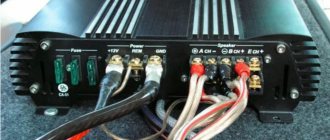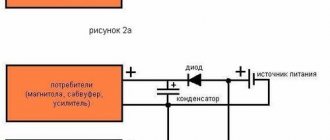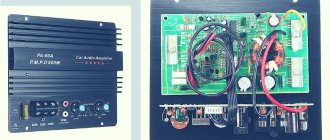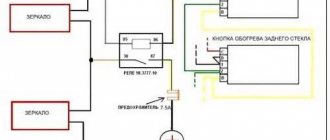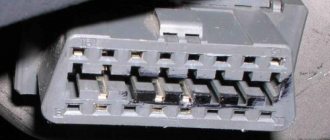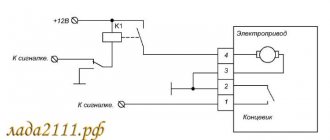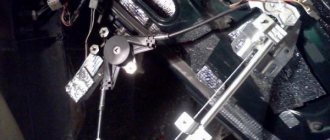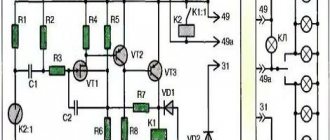In electrodynamic heads that are used in subwoofers, there are models equipped with two voice coils. Such speakers are no different in appearance from ordinary speakers, and their only difference is the additional terminals for connecting the second winding. The material, number of turns and electrical parameters of the sound windings are the same. Usually subwoofers have a winding resistance of 4 or 2 ohms, but there are heads with other coils.
It happens that one subwoofer model is offered in two versions: with one sound winding or with two.
Subs with one coil 2 and 4 Ohm
1 sub with two and one 4 ohm coils
1 sub with two 2 ohm coils
3 subwoofers with two and one 4 ohm coils
4 subwoofers with two 4 ohm coils
3 subwoofers with two 2 ohm coils
4 subwoofers with two 4 ohm coils
4 subwoofers with two coils of 2 ohms, resistance 1 ohm
4 subwoofers with two 2 ohm coils
4 subwoofers with two 4 ohm coils
4 subwoofers with one 8 ohm coil
2 subwoofers with one 8 ohm coil
admin
How to setup
On the front panel of the 4-channel amplifier there are controls and switches that set various parameters. You must make sure that the power indicator is on and the protection alarm is not on before setting up the amplifier. Otherwise, the problem is detected and corrected.
The first stage of setting up a bridge amplifier is to adjust the input level necessary to match the radio. This indicator is set using a regulator or switch. If the radio is connected to high-level inputs, then this control is first set to the 6 V position. Then the lowest input level is set at which the sound remains undistorted when the volume control of the radio is in the high position. After this, the amplifier is configured for all other parameters.
How to connect a monoblock in 1 ohm
It may be easier to connect a single-coil subwoofer to a monoblock or multi-channel amplifier. It's a completely different matter if the subwoofer has two voice coils or two or more of them.
A two-coil subwoofer, as well as two, three or more subwoofers, can be connected in four ways: each coil separately, parallel connection of coils, serial and combined.
What each of these subwoofer switching options gives is, first of all, versatility, different capabilities. Let's consider each option separately. But first of all, you need to understand what happens when the coils are connected in parallel or in series.
When the coils are connected in parallel, the total resistance, roughly speaking, becomes half as much. For example: if we connect two 4 Ohm coils in parallel, we get a total resistance of 2 Ohms, if we connect two 2 Ohm coils, we get a total resistance of 1 Ohm.
The opposite effect occurs with a series connection. When connecting two 4 Ohm coils in series, we get a resistance of 8 Ohms, when connecting two 2 Ohm coils, we get 4 Ohms. etc.
Connecting each coil separately . This option allows you to connect a powerful two-coil subwoofer to a less powerful four-channel amplifier if it is not possible or not possible to purchase a powerful monoblock. Naturally, the resistance of the coils must correspond to the operating load of the amplifier in a bridge connection and the GAIN controls must be at the same level.
Parallel connection of coils - subwoofers.
As described above, when connected in parallel, the resistance is halved, allowing the amplifier, operating at a lower load, to deliver more power.
But as they say, “if it leaves somewhere, it will definitely arrive somewhere.” In this case, this is true, only on the contrary, the power has increased, and the amplifier’s control over the subwoofer has decreased, as a result of which the bass becomes smeared.
Series connection of coils . If the amplifier is powerful, why not, increase the impedance (resistance) and get a more developed bass.
I would also like to add that if the resistance of the connected coils exceeds the permissible load of the amplifier, this is not at all scary, it’s just that the output power of the amplifier will be less.
Let's say an amplifier with a declared operation for a load of 4 ohms produces 500 watts, and with a load of 8 ohms, for example, it will produce 350 watts.
Combined connection . Subwoofers are coils that are simultaneously connected in serial and parallel connections for switching to a specific load. There are a great many connection options, it all depends on the number of subwoofer speakers, the resistance of the subwoofer voice coils and the capabilities of the amplifier.
“Every little one knows, black is a minus, red is a plus!”
Connecting the subwoofer to the radio
It is necessary to connect the subwoofer to the radio only through an amplifier. Since the built-in power of the radio is not enough for the subwoofer to work properly, you will not get normal bass. The connection chain is simple: radio-amplifier-subwoofer. The radio transmits the signal to the amplifier. The amplifier, in turn, amplifies this signal and sends it to the subwoofer.
What is an amplifier for?
The amplifier is used to increase the volume headroom, reduce distortion and improve the sound quality of music. The built-in amplifier of the radio is not enough to drive a heavy low-frequency speaker, which will cause large distortions, the volume level will be low and, with a high probability, the subwoofer may fail or simply “burn out.”
If you have an active subwoofer, then you will not need an additional amplifier, because it is already built into the subwoofer housing (more about active subwoofers). For a passive subwoofer you will have to choose an amplifier (read how to do this correctly on this page).
How to connect a subwoofer to an amplifier
Single channel connection
Connecting a subwoofer to an amplifier is not difficult; just connect the amplifier's audio output jack to the subwoofer coil or coils using speaker wires.
The wires should not be thin. In most cases, choose copper wiring with a cross-section of 4 mm and there will be no problems.
Connecting speaker wires
This subwoofer connection diagram is suitable for one channel of an amplifier or monoblock.
Monoblock is a single-channel amplifier designed specifically for subwoofers.
Connecting to a subwoofer via terminal block
Setting up the car's multimedia system
Connecting to a subwoofer directly
Connecting a subwoofer with a bridge
- In the case of using a multi-channel amplifier, the sub can be connected to two channels simultaneously, using the minus of one and the plus of the other, this connection is called bridged, with this method the power output by the amplifier increases significantly (see the specifications for specific numbers).
- So you can connect a subwoofer to a two or four channel amplifier, using 2 channels for acoustics, and the remaining 2 for the subwoofer.
- To connect a subwoofer with a bridge, make sure that your amplifier supports this feature.
- If you connect a low-frequency speaker to an amplifier by changing the polarity, that is, connect the plus of the subwoofer to the minus of the amplifier output and vice versa, then the speaker will work in antiphase, there is nothing wrong with that, sometimes such a connection is used intentionally if the amplifier does not have phase adjustment (more about adjustment phases).
Connecting the subwoofer coils
The technical documentation for the subwoofer states the resistance of its coils (1 Ohm, 2 Ohm, 4 Ohm, rarely 0.
5 Ohms), and the technical documentation of the amplifier indicates what resistances it can work with; this information is needed so that you correctly and effectively connect the subwoofer to the amplifier.
The lower the resistance of the sub, the more power the amplifier will produce, provided that it can operate at this resistance. A subwoofer speaker may have several coils (1 or 2, rarely 4).
When the coils are connected in series, the resistance increases, while in parallel it decreases. If you don't want to learn definitions and count fractions, just save this cheat sheet (parallel and serial connections).
How much ohm to connect the subwoofer
The higher the resistance, the better the sound quality; the lower, the more power the amplifier delivers. If you need a lot of loud bass, then turn it to the minimum that the amplifier can provide, and if the overall sound quality of the system comes first, then it is 2 Ohms or 4 Ohms, depending on the power output.
Video on how to connect 2 subwoofers or more. Subwoofer connection diagram 2x2 Ohm, 4x4 Ohm, 1x1 Ohm. Serial connection of speakers. Parallel connection of speakers. Basic principles.
- Happy connections!
- I decided to post some subwoofer connection diagrams... someone might need it...
see also
lmplex › Blog › Connecting a car amplifier
Connecting a car amplifier in a car causes fear for many.
Of course, for a person, even with a secondary technical education, this can be simple. But for many others it may be a difficult task to solve. Here, of course, people turn to car repair shops, car studios, etc. In this article I will try to tell and show in an accessible and simple language that connecting a car amplifier is actually a simple matter.
Where to start? You have a car, the desire to enjoy good sound in it, the desire to do everything yourself - this is the most important thing.
The most important thing to begin with is to decide what we want to do. There are a lot of options for building a car audio system. And of course, since we decided to equip our iron horse with a car amplifier, it means that something does not suit us, the sound quality or insufficient volume.
A few words about what a car amplifier is.
Of course, there are also simple amplifiers that we have at home in music centers, home theaters, etc. - but these are stationary amplifiers, they are powered by a 220 volt network. There is no such voltage in the car; there is only 12 volts of the on-board network. That's why a car amplifier is called a car amplifier, because. designed for this low voltage in the car.
How does it give us more power? Everything is very simple and very complex. I won’t tell you what’s complicated, it’s a huge and boring lecture on radio electronics and physics, I’ll just say it. The car amplifier has a pulse voltage converter - it increases the existing 12 volts to bipolar voltage, with an amplitude of 30 to 100 volts (depending on the power of the amplifier). Thus, the amplifier provides itself with the necessary voltage from the available one. If someone was very interested and looked inside the car amplifier, he saw there a transformer wound on a ring of ferromagnets - this is the main part of the step-up pulse voltage converter.
Well, then - a regular power amplifier, almost the same as in a home one.
Choosing a car amplifier.
The most common reason for installing a car amplifier is a subwoofer. For a subwoofer, we need at least a two-channel amplifier that can operate in bridge mode, i.e. when the left and right channels work for the same load - the subwoofer speaker.
Another variant. I don’t like that the speakers start to wheeze at high power. This happens when the speakers are connected to the car radio amplifier. Of course, the car radio also has its own amplifier, but it is low-power, the maximum it can produce is up to 27 watts per channel, and do not believe the loud signs that a power of 40 or 50 watts and above is not musical power, but peak noise power. In this case, all speakers are connected to a car amplifier having 2 or 4 channels.
When you want both the first and second options at the same time, either a five-channel amplifier or two separate ones can help.
Another important point is the presence on the car radio of linear outputs for connecting a car amplifier. These are “Tulip” or “RCA” type connectors located on the back of it. If you don’t know whether you have them and how many there are, look in the documentation or search by the name of the radio on the Internet, we are interested in the item - linear outputs. There may be none at all, maybe 2, 4, 5, etc. for more advanced copies.
If they are not there, then there is no reason to despair, there is a way out - the car amplifier can be connected directly to the output of the car radio speakers. But of course not directly, but through a special attenuator (a device for reducing amplitude). Its design is elementary simple, all you need is 4 resistors, two with a resistance of 100 Ohms and two with a resistance of 1 kOhm (kiloOhm). You can buy them at the radio market, in a radio store, or pick them out of an old TV, receiver, etc. In general, this is the cheapest and most common part of all existing ones.
Marking: on the body of a resistor with a resistance of 1 kOhm there will be an inscription - 1k, or color stripes - brown, black, red, silver. On the body of a resistor with a resistance of 100 Ohms - k10, or 100, or colored stripes - brown, black, brown, silver. There may be resistors with European markings, in which case a 1 kOhm resistor will be marked 102, and a 100 Ohm resistor will be marked 101. Here the first two digits are the nominal value, and the third is the multiplier. The resistor connection diagram will look like this:
If there are linear outputs, then everything is much simpler. For a two-channel amplifier for a subwoofer, you will need two RCAs for the front or rear. The same amount is enough if you want to connect rear speakers (pancakes) to a car amplifier. If you need to separate the front and rear, you will need 4 RCA connectors (front and rear output, respectively). On some car radio models, the subwoofer output is made in the form of 1 RCA connector. For a two-channel amplifier, it will also have to be split into left + right.
So, a little trick if there is only one RCA linear output, but you need to connect two amplifiers or branch it to the front and rear. RCA splitters will come to the rescue. There are a huge number of options for their execution, but the essence is the same - one “tulip” at the entrance and two at the exit.
We figured out what to connect where, now we move on to choosing a car amplifier.
Choosing a car amplifier among the many on sale is actually not easy. There are both inexpensive and very expensive ones. By manufacturer - well-known Hyundai, Prology, etc. and more expensive ones - Rockford, Poweramper, Kicker, Lanzar, etc.
If we have decided on the number of channels, then the next parameter will be power per channel. For front/rear acoustics, it is advisable to take the channel power slightly less than the rated power of the speaker, this will save it from overload and there will be no nasty wheezing. For a subwoofer - look at the connection parameter in bridge mode, again, it is desirable that it be slightly less than the rated power of the subwoofer speaker.
The next parameter is the load resistance. The load is the speaker, it has a coil resistance, the value can be 2, 4, 6 or 8 ohms. The load resistance for which the car amplifier is designed should not be less than the nominal value, it can be more, but not less. For example, your speakers are rated at 2 ohms, and the amplifier is designed for 4. In this case, there is a high chance of “burning” both the amplifier and the speakers. Equal values should be selected, or the speaker impedance should be greater.
How to connect a subwoofer in a car
“Every little one knows, black is a minus, red is a plus!”
Connecting the subwoofer to the radio
It is necessary to connect the subwoofer to the radio only through an amplifier. Since the built-in power of the radio is not enough for the subwoofer to work properly, you will not get normal bass. The connection chain is simple: radio-amplifier-subwoofer. The radio transmits the signal to the amplifier. The amplifier, in turn, amplifies this signal and sends it to the subwoofer.
What is an amplifier for?
The amplifier is used to increase the volume headroom, reduce distortion and improve the sound quality of music. The built-in amplifier of the radio is not enough to drive a heavy low-frequency speaker, which will cause large distortions, the volume level will be low and, with a high probability, the subwoofer may fail or simply “burn out.”
If you have an active subwoofer, then you will not need an additional amplifier, because it is already built into the subwoofer housing (more about active subwoofers). For a passive subwoofer you will have to choose an amplifier (read how to do this correctly on this page).
How to connect a subwoofer to an amplifier
Single channel connection
Connecting a subwoofer to an amplifier is not difficult; just connect the amplifier's audio output jack to the subwoofer coil or coils using speaker wires.
The wires should not be thin. In most cases, choose copper wiring with a cross-section of 4.2 square meters. mm and there will be no problems.
Connecting speaker wires
This subwoofer connection diagram is suitable for one channel of an amplifier or monoblock. If a 1-channel amplifier has two pluses and minuses, then don’t get lost, these pairs are simply paralleled for ease of switching. And it makes no difference which of the pluses and minuses the corresponding wire is connected to.
Monoblock is a single-channel amplifier designed specifically for subwoofers.
Connecting to a subwoofer via a terminal block Connecting to a subwoofer directly
Connecting a subwoofer with a bridge
- In the case of using a multi-channel amplifier, the sub can be connected to two channels simultaneously, using the minus of one and the plus of the other, this connection is called bridged, with this method the power output by the amplifier increases significantly (see the specifications for specific numbers).
- So you can connect a subwoofer to a two or four channel amplifier, using 2 channels for acoustics, and the remaining 2 for the subwoofer.
- To connect a subwoofer with a bridge, make sure that your amplifier supports this feature.
- If you connect a low-frequency speaker to an amplifier by changing the polarity, that is, connect the plus of the subwoofer to the minus of the amplifier output and vice versa, then the speaker will work in antiphase, there is nothing wrong with that, sometimes such a connection is used intentionally if the amplifier does not have phase adjustment (more about adjustment phases).
Connecting the subwoofer coils
The technical documentation for the subwoofer states the resistance of its coils (1 Ohm, 2 Ohm, 4 Ohm, rarely 0.
5 Ohms), and the technical documentation of the amplifier indicates what resistances it can work with; this information is needed so that you correctly and effectively connect the subwoofer to the amplifier.
The lower the resistance of the sub, the more power the amplifier will produce, provided that it can operate at this resistance. A subwoofer speaker may have several coils (1 or 2, rarely 4).
When the coils are connected in series, the resistance increases, while in parallel it decreases. If you don't want to learn definitions and count fractions, just save this cheat sheet (parallel and serial connections).
Connection options
How many ohms should I connect the subwoofer to?
The higher the resistance, the better the sound quality; the lower, the more power the amplifier delivers. If you need a lot of loud bass, then turn it to the minimum that the amplifier can provide, and if the overall sound quality of the system comes first, then it is 2 Ohms or 4 Ohms, depending on the power output.
Video on how to connect 2 subwoofers or more. Subwoofer connection diagram 2x2 Ohm, 4x4 Ohm, 1x1 Ohm. Serial connection of speakers. Parallel connection of speakers. Basic principles.
Happy connections!
List of required components
To begin with, let’s decide on a general list of parts, namely their name and function, and then give a recommendation for selection.
- Power wire. Supplies power from the battery to the amplifier. For a medium-sized sedan you will need 5 m of “plus” and 1 m of “minus”. You can get more accurate dimensions by measuring your car yourself.
- Bulb with fuse. An important component. Serves as protection in the event of a short circuit in the power cable.
- Terminals. Allows you to simplify the connection of power wires to the battery and car body. You will need 2 pcs. ring type. If the connection to the amplifier is on the blades, you will need 2 more pieces. fork type.
- Tulips and control wire. Transmits an audio signal from the radio to the amplifier. Can come complete with interconnect cables or be purchased separately.
- Speaker wire. Transfers an improved signal from the amplifier to the subwoofer. You will need 1-2 m. If you have an active subwoofer, this wire will not be needed.
- Additionally, a distributor may be needed if two amplifiers are installed.
Methods for connecting subwoofers | Useful car audio
June 17, 2019
// Useful car audio
One of the most important components in audio systems is the subwoofer.
A subwoofer is a speaker designed to reproduce low frequencies that are at the lower sensitivity threshold of the human ear. The term "Subwoofer" is used to describe a system with a low-frequency driver housed in a separate housing.
Terminology
- Maximum sound pressure. Maximum subwoofer volume.
- Frequency range (Hz). The frequency range of the subwoofer can be divided into the area of deep bass 20-40 Hz, medium bass 40-80 Hz, high bass (midbass) 80-160 Hz.
- Sensitivity (dB). The more sensitive the dynamics, the less the amplifier is loaded, the greater the sound pressure it produces at the same power.
- The larger the diffuser size, and therefore the area, the more powerful the bass.
Connecting a subwoofer
Proper connection of a subwoofer with two coils is very important, especially when the amplifier is not capable of operating in a low-impedance load or is too powerful in relation to the speaker. Do not expose the amplifier to loads lower than those permitted by the manufacturer.
The table below shows the connection resistance options.
Connection methods
Parallel connection of speakers Series connection of speakers
| Methods for connecting subwoofers | |||
| Number of speakers | Voice coil | Total impedance | Connection diagram |
| 1 speaker | 4+4 Ohm | 2 ohm | |
| 2+2 Ohm | 1 ohm | ||
| 1+1 Ohm | 0.5 Ohm | ||
| 2 speakers | 4+4 Ohm | 1 ohm | |
| 2+2 Ohm | 0.5 Ohm | ||
| 1+1 Ohm | 0.25 Ohm | ||
| 1 speaker | 4+4 Ohm | 8 ohm | |
| 2+2 Ohm | 4 ohm | ||
| 1+1 Ohm | 2 ohm | ||
| 2 speakers | 4+4 Ohm | 4 ohm | |
| 2+2 Ohm | 2 ohm | ||
| 1+1 Ohm | 1 ohm |
A set of cables for a subwoofer, a budget option for weak systems
A common option is to purchase a ready-made set of wires. This solution has its advantages. Firstly, such kits are inexpensive. Secondly, the box contains everything you need to connect.
There is one minus. These kits use aluminum wires coated with copper. They have high resistance, which affects throughput. Depending on conditions, they oxidize and rot over time. This option is suitable for those who have a modest budget and low system power, for example, for connecting an active subwoofer.
